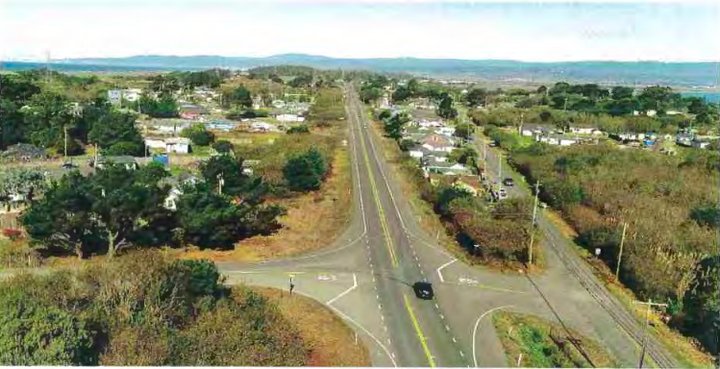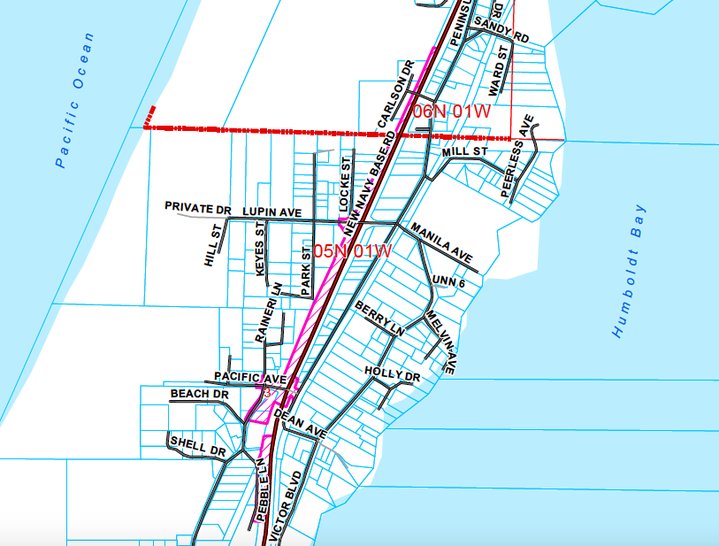
An aerial view of Manila. | Photo from a Humboldt County Planning Department staff report.
# # #
The tiny community of Manila, which lies scattered across the Samoa Peninsula between coastal sand dunes and the shores of Humboldt Bay, gets sliced right down the middle by State Route 255.
There’s a 55-miles-per-hour speed limit on this straightaway, which is also known as New Navy Base Road, but speeding is so common that locals often post handmade signs urging people to slow down.
On one side of the road you’ll find a K-12 Montessori school, the offices of the community services district and the Humboldt Coastal Nature Center, whose arched facade of concrete and glass is built into a hillside like a Hobbit house. On the other side you’ll find a church, a mini-mart (with a shuttered mini-golf course) and the community park. The town’s wooden homes and metal trailers, blasted by wind and sand, straddle the roadway without so much as a crosswalk connecting them.
For decades residents have called on government officials to make their community safer and more friendly for cyclists and pedestrians. A new joint project from Humboldt County and Caltrans aims to do just that.
On Thursday, the Humboldt County Planning Commission approved a coastal development permit for a Class I bike path through Manila. The paved, multi-use trail would be 10 feet wide and run parallel to 255, separated by at least five feet from the western edge of the road. It would extend from the intersection with Dean and Pacific Avenues at the south end of town and run 0.6 miles north, ending just past Carlson Drive.

Detail of a map of the project area from the county staff report. The project area is in pink.
# # #
This northern terminus winds up near the Hobbit house of the Humboldt Coastal Nature Center, which is managed by the nonprofit Friends of the Dunes. The trail was designed to eventually connect to the nature center via another trail, which is in the early stages of development. According to county staff, this connection would not only encourage more use of the new bike trail, it would also give the community an extra tsunami evacuation route.
Construction costs for the trail, estimated at $1.5 million, would be covered by the state’s Active Transportation Program.
The longer-term goal is to have non-motorized trails connecting Arcata, Manila, the Samoa Bridge(s), Samoa itself and Fairhaven. And while this current trail project wouldn’t connect Manila’s two halves to each other, residents who called in to Thursday’s meeting (held via Zoom due to COVID-19) expressed enthusiastic support.
Carla Osborn said she lives on the east side of 255 and visits the beach daily. “I drive the dogs across [255] because the highway and shoulder are extremely unfriendly to pedestrians,” she said. “I’m thrilled at the idea of having a walking trail in Manila, and I hope one day it will go all the way to Arcata. I can’t imagine why this would be considered a bad idea.”
The Peninsula Community Collaborative (PCC), a local civic group, has been advocating for improved bike and pedestrian safety. Emily Sinkhorn, a staff member with the Redwood Community Action Agency, has been helping the PCC organize, and she called in to Thursday’s meeting.
“Through extensive community conversations and surveying, we’ve really seen that people are concerned about walking along and across Highway 255,” Sinkhorn said. “And it’s a top concern.”
Carol Vander Meer, a Manila resident and former executive director of Friends of the Dunes, also urged the commission to approve the permit. “This has really been a top community priority, and I’m pleased that the county has responded to the desires of the community and what’s been voiced over decades now,” she said.
A number of other community members spoke in favor of the project, but two callers declined to join the chorus of full-throated support. Uri Driscoll — a former candidate for county supervisor, longtime antagonist of Friends of the Dunes and current president of the Humboldt County Taxpayers League — was one. The other was Kent Sawatzky, local property manager, insatiable commenter at public meetings and executive director (and only publicly known other member) of the Humboldt County Taxpayers League.
Both said they support trails in concept but questioned the design and environmental impacts of this particular project. Sawatzky challenged planning staff’s assertion that the project is exempt from environmental review because it’s considered part of an “existing facility” under the California Environmental Quality Act (CEQA).
“[B]ut the facility doesn’t exist,” he said. “It’s a wetland, allegedly. There is no trail there.”
Humboldt County Deputy Director of Environmental Services Hank Seemann explained during the meeting that the “facility” in question is Caltrans’ transportation corridor, State Route 255.
Driscoll had submitted a letter in which he enumerated a list of objections, including the project’s proposed mitigations for wetland impacts, the apparent lack of a trailhead or parking facilities, an alleged intrusions on the privacy of adjacent landowners and more.
“I would just kind of like a better project, really,” Driscoll told the Outpost on Monday.
According to the staff report, the project would directly impact about 0.77 acres of wetland, which would be mitigated by creating 0.92 acres of new wetlands elsewhere in the project area. Driscoll argued that the new wetland area, though slightly larger, wouldn’t fully compensate for the loss of more established wetlands.
He also questioned the design of the trail itself, which would primarily consist of a paved pathway atop a berm. He suggested that a raised boardwalk would be a better, less environmentally disruptive design.
During Thursday’s meeting, Commissioner Noah Levy raised some of these issues with staff. Seemann said that a raised boardwalk would not be technically or financially feasible for the entire length of this trail, and regarding the wetlands he said staff plans to monitor the newly created wetland using performance criteria for vegetation and hydrology.
Levy appeared satisfied, and when it came time to vote, the decision was unanimous: All six current planning commissioners voted to approve the permit.
On Monday, Driscoll told the Outpost via email that he remains concerned about the project.
“Our main objections stem around wetland impacts and the fact that this trail stops 1/4 mile short of any parking area (Manila school) … ,” he wrote. “In short we would like to see a project that is less damaging to the wetlands and continues to the school and the parking area.”
Asked who the collective pronouns referred to, Driscoll replied, “There are several of us that are pretty disappointed in this plan. I would want to get their permission before giving names.”
This unidentified group has yet to decide whether they will appeal the decision, though they believe they have grounds, Driscoll said. If they decide to do so, who will hear the appeal? Well, Humboldt County code says that a coastal development permit can be appealed to the California Coastal Commission only after the “aggrieved” party “has exhausted local appeals.”
But Driscoll said he was informed by Planning and Building Director John Ford that an appeal to the Board of Supervisors would cost $1,000. Driscoll pointed to a Coastal Commission policy, which states, “An appellant must have exhausted all local appeals unless the local government charges a fee to appeal [emphasis added].”
The Outpost left messages for Ford, asking for clarity on the appeal process. We’ll update this post if and when we hear back.
# # #
UPDATE, 12:35 p.m.: Very shortly after this post was published, Ford called me up and said his understanding was that, as county code states, Driscoll would need to appeal to the Board of Supervisors first, before taking the matter to the Coastal Commission. Told about the Coastal Commission’s fee policy he said, “That’s a new one for me. If that was the case we would waive the appeal fee.”
I then emailed him a link to the policy language, and after reading it aloud he said, “Huh. Well, okay. I’ll update my email to Uri and tell him there’s no fee.”
# # #
UPDATE, May 13: Scratch that, Ford said in a follow-up email. “I did some research and the County requires payment of a fee for an appeal so the appeal is directly to the Coastal Commission,” he said. “I apologize for any confusion.”
CLICK TO MANAGE